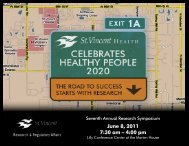Making Data Talk: A Workbook - National Cancer Institute
Making Data Talk: A Workbook - National Cancer Institute
Making Data Talk: A Workbook - National Cancer Institute
- No tags were found...
Create successful ePaper yourself
Turn your PDF publications into a flip-book with our unique Google optimized e-Paper software.
Innovations in computer and other technological interfaces reflect the new wave of opportunities for data toimpact health. Patient health data in electronic medical records can prompt clinicians to recommend screenings,support decision-making on treatment, and monitor adherence to treatment protocols. At the population level, datafrom health systems, coupled with other surveillance systems, can uncover health disparities and further promptaction toward achieving health equity. With these innovations in health information technology, communicatingdata effectively that will enable lay audiences to understand and be empowered may be the biggest challengeconfronting researchers and practitioners.ClosingCommunicating health data to lay audiences is a complex process, especially when taking into account the contextand other considerations associated with the data, health topic, or environment. You must carefully consider all ofthese factors before deciding whether data should be used in key messages, what data to communicate, and how topresent selected data effectively. For public health professionals, it is always helpful to have an approach like the OPT-Inframework that helps guide the planning and implementation of communication tasks. This framework can be readilyused to communicate data and other health information across settings and in a variety of different situations. Wehope this framework, along with the content and the practical exercises, helps promote your understanding of theconcepts outlined in this workbook and can increase your ability to successfully apply them in your work.ReferencesIntroduction1 Nelson DE, Hesse BW, Croyle RT. <strong>Making</strong> <strong>Data</strong> <strong>Talk</strong>: Communicating Public Health <strong>Data</strong> to the Public, PolicyMakers, and the Press. New York, NY: Oxford University Press; 2009.Chapter 12Kahneman D, Slovic P, Tversky A, ed. Judgment under Uncertainty: Heuristics and Biases. Cambridge, UK:Cambridge University Press; 1982.Slovic P. The Perception of Risk. London; Sterling, VA: Earthscan; 2000.3 Miller JD, Kimmel LG. Biomedical Communications: Purposes, Methods, and Strategies. San Diego, CA:Academic Press; 2001.Chapter 24 Hornik RC, ed. Public Health Communication: Evidence for Behavior Change. Mahwah, NJ: L. ErlbaumAssociates; 2002.Additional sources for Figure 2.1:Littlejohn SW, Foss KA. Theories of Human Communication. 9th ed. Belmont, CA: Wadsworth; 2007.McQuail D. McQuail’s Mass Communication Theory. 5th ed. London, UK: Sage; 2005.Additional sources for Table 2.3:Arceneaux K. The “gender gap” in state legislative representation: New data to tackle an old question.Polit Res Q. 2001;54:143–160.40





